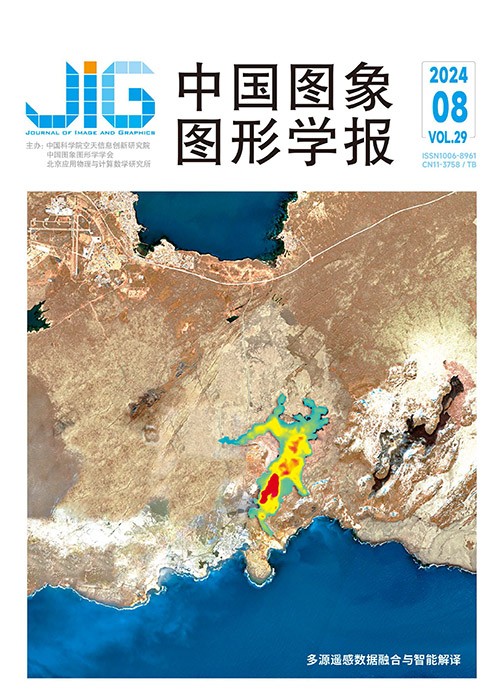
基于深度学习的光谱图像超分辨率综述
张涛1,2, 王彬沣3, 付莹3, 刘松荣4, 叶吉超5, 单培红6, 颜成钢1,2(1.杭州电子科技大学通信工程学院, 杭州 310018;2.杭州电子科技大学丽水研究院, 丽水 323000;3.北京理工大学计算机学院, 北京 100081;4.浙江交投高速公路运营管理有限公司, 丽水 323000;5.国网浙江省电力有限公司, 丽水 323000;6.浙江省公众信息产业有限公司, 杭州 310000) 摘 要
光谱图像超分辨率技术的目的是从低空间分辨率和光谱分辨率的图像中恢复高空间分辨率和光谱分辨率的图像,在植被调查、地质勘探、环境保护、异常检测和目标追踪等遥感领域有着广泛应用。随着深度学习的兴起,基于深度学习的光谱图像超分辨率算法如雨后春笋般涌现,特别是卷积神经网络、Transformer、生成对抗网络以及深度展开网络等技术的出现使图像融合性能产生了质的飞跃。本文全面探讨和分析了不同光谱图像超分辨率任务场景下的前沿深度学习算法。首先,介绍了光谱图像超分辨率的基本概念,以及不同超分辨率场景的定义。针对单图超分辨率和融合超分辨率两大场景,从超分辨率维度、数据类型、基本框架和监督方式等多个角度详细阐述了各类方法的基本思想和特点。其次,总结了各类算法存在的局限性,并提出了进一步改进的方向。然后,简要介绍了不同融合场景中常用的数据集,并明确了各种评估指标的具体定义。对于每种超分辨率任务,从定性评估、定量评估等多个角度全面比较了代表性算法的性能。最后,总结了研究结果,并探讨了光谱图像超分辨率领域所面临的一些严峻挑战,同时对未来可能的研究方向进行了展望。所提及的算法和数据集已汇总至https://github.com/ColinTaoZhang/DL-based-spectral-super-resolution。
关键词
Deep learning-based spectral image super-resolution: a survey
Zhang Tao1,2, Wang Binfeng3, Fu Ying3, Liu Songrong4, Ye Jichao5, Shan Peihong6, Yan Chenggang1,2(1.School of Communication Engineering, Hangzhou Dianzi University, Hangzhou 310018, China;2.Lishui Institute, Hangzhou Dianzi University, Lishui 323000, China;3.School of Computer Science and Technology, Beijing Institute of Technology, Beijing 100081, China;4.Zhejiang Communications Involvement Expressway Operation Management Co., Ltd., Lishui 323000, China;5.State Grid Zhejiang Electric Power Co., Ltd., Lishui 323000, China;6.Zhejiang Public Information Industry Co., Ltd., Hangzhou 310000, China) Abstract
The goal of spectral image super-resolution technology is to recover images with high spatial resolution and spectral resolution from images with low spatial resolution and spectral resolution. Images of high spatial and spectral resolution are widely used in remote sensing fields such as vegetation survey, geological exploration, environmental protection, anomaly detection, and target tracking. With the rise of deep learning, spectral image super-resolution algorithms based on deep learning have emerged. In particular, the emergence of technologies such as end-to-end neural networks, generative adversarial networks, and deep unfolding networks has made a qualitative leap in spectral image super-resolution performance. This study comprehensively discusses and analyzes cutting-edge deep learning algorithms under different spectral image super-resolution task scenarios. First, we introduce the basic concepts of spectral image super-resolution and the definitions of different super-resolution scenarios. Focusing on the two major scenarios of single-image super-resolution and fusion super-resolution, the basic concepts of various methods are elaborated from multiple perspectives such as super-resolution dimensions, super-resolution data types, basic frameworks, and supervision methods, and their characteristics are discussed. Second, this study summarizes the limitations of various algorithms and proposes directions for further improvement. Furthermore, the commonly used datasets in different fusion scenarios are briefly introduced, and the specific definitions of various evaluation indicators are clarified. For each super-resolution task, this study comprehensively compares the performance of representative algorithms from multiple perspectives such as qualitative evaluation and quantitative evaluation. Finally, this study summarizes the research results and discusses some serious challenges faced in the field of spectral image super-resolution, while also looking forward to possible future research directions. First, from the perspective of super-resolution scenarios, the existing spectral image super-resolution algorithms can be divided into two categories, namely, single image super-resolution and fusion-based super-resolution. Specifically, single spectral image super-resolution is designed to generate high-resolution output images from a single low-resolution input image. According to the direction of super-resolution, single image super-resolution can be divided into spatial super-resolution, spectral super-resolution, and spatial-spectral super-resolution. Fusion-based spectral image super-resolution is designed to fuse images of different modes into a single image with high spatial and spectral resolution. According to the different modes of fusion images, fusion-based spectral image super-resolution can be divided into pansharpening and multispectral and hyperspectral images fusion. Moreover, deep learning-based spectral image super-resolution methods can be categorized into end-to-end neural network based (E2EN-based) spectral image super-resolution framework, generative adversarial network-based (GAN-based) spectral image super-resolution framework, and deep unfolding network-based (DUN-based) spectral image super-resolution framework according to the network architecture. The E2EN-based spectral image super-resolution framework designs various network structures to mine nonlinear mapping relationships between low-resolution and high-resolution images. According to the basic computing unit of network structure, it can be divided into convolutional neural network-based method and Transformer-based method. The GAN-based spectral image super-resolution framework realizes the spectral image super-resolution through the game between the generator and the discriminator. The DUN-based spectral image super-resolution framework combines traditional optimization algorithms and deep learning, and it unfolds iterative optimization steps to form deep neural networks. From the perspective of supervision paradigm, the deep learning algorithms can also be classified into unsupervised and supervised categories. The supervised approaches minimize the distance between super-resolved spectral image and ground truth, while unsupervised algorithms design loss function through the similarity between super-resolved and input images or through the game of the generator and the discriminator. Our critical review describes the main concepts and characteristics of each approach for different spectral image super-resolution tasks according to the network architecture and supervision paradigm. Second, we introduce the representative datasets and evaluation metrics. We divide the datasets into categories of single spectral image super-resolution datasets and fusion-based spectral image super-resolution datasets. Furthermore, the evaluation metrics can be grouped into full-reference metrics and no-reference metrics. Some full-reference metrics are widely used for the quantitative evaluation of spectral image super-resolution, including peak signal-to-noise, structural similarity, spectral angle mapper, and relative dimensionless global error in synthesis. Third, we provide the quantitative and qualitative experimental results of different spectral image super-resolution tasks. Finally, we summarize the challenges and problems in the study of deep learning-based spectral image super-resolution and conduct forecasting analysis, such as high-quality spectral image super-resolution dataset, model-driven and deep learning combined spectral image super-resolution method, real-time spectral image super-resolution, and comprehensive evaluation metrics. The methods and datasets mentioned are linked at https://github.com/ColinTaoZhang/DL-based-spectral-super-resolution.
Keywords
deep learning super-resolution spectral image single image super-resolution fusion-based super-resolution
|



 中国图象图形学报 │ 京ICP备05080539号-4 │ 本系统由
中国图象图形学报 │ 京ICP备05080539号-4 │ 本系统由